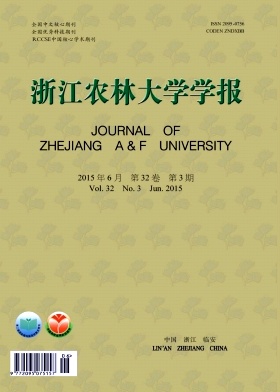| [1] |
DENG Zaichun, ZHANG Chao, ZHU Xiali, FAN Jinming, QIAN Hui, LI Chengrong.
Pinus yunnanensis volume estimation model based on UAV multispectral image
. Journal of Zhejiang A&F University,
2024, 41(1): 49-56.
doi: 10.11833/j.issn.2095-0756.20230263
|
| [2] |
ZHU Zan, YUAN Xiping, GAN Shu, ZHANG Liangjie, ZHAO Qinghui.
GF-1 remote sensing data for Panax notoginseng planting information extraction in Wenshan, Yunnan Province
. Journal of Zhejiang A&F University,
2020, 37(1): 129-135.
doi: 10.11833/j.issn.2095-0756.2020.01.017
|
| [3] |
LAN Jie, XIAO Zhongqi, LI Jimei, ZHANG Yutao.
Biomass allocation and allometric growth of Picea schrenkiana in Tianshan Mountains
. Journal of Zhejiang A&F University,
2020, 37(3): 416-423.
doi: 10.11833/j.issn.2095-0756.20190384
|
| [4] |
XIE Qiaoya, YU Kunyong, DENG Yangbo, LIU Jian, FAN Huadong, LIN Tongzhou.
Height measurement of Cunninghamia lanceolata plantations based on UAV remote sensing
. Journal of Zhejiang A&F University,
2019, 36(2): 335-342.
doi: 10.11833/j.issn.2095-0756.2019.02.015
|
| [5] |
SHEN Jiapeng, CHEN Dongsheng, SUN Xiaomei, ZHANG Shougong.
Modeling a single-tree biomass equation by seemingly unrelated regression and dummy variables with Larix kaempferi
. Journal of Zhejiang A&F University,
2019, 36(5): 877-885.
doi: 10.11833/j.issn.2095-0756.2019.05.005
|
| [6] |
XIE Fuming, ZI Li, SHU Qingtai.
Optimizing the k-nearest neighbors technique for estimating Pinus densata aboveground biomass based on remote sensing
. Journal of Zhejiang A&F University,
2019, 36(3): 515-523.
doi: 10.11833/j.issn.2095-0756.2019.03.012
|
| [7] |
LUO Hengchun, ZHANG Chao, WEI Anchao, ZHANG Yi, HUANG Tian, YU Zhexiu.
Average DBH growth model of a stand with environmental parameters for Pinus yunnanensis in central Yunnan, China
. Journal of Zhejiang A&F University,
2018, 35(6): 1079-1087.
doi: 10.11833/j.issn.2095-0756.2018.06.011
|
| [8] |
TAO Jiangyue, LIU Lijuan, PANG Yong, LI Dengqiu, FENG Yunyun, WANG Xue, DING Youli, PENG Qiong, XIAO Wenhui.
Automatic identification of tree species based on airborne LiDAR and hyperspectral data
. Journal of Zhejiang A&F University,
2018, 35(2): 314-323.
doi: 10.11833/j.issn.2095-0756.2018.02.016
|
| [9] |
WANG Haibin, PENG Daoli, GAO Xiuhui, LI Wenfang.
Forest stock volume estimates in Yanqing District based on GF-1 PMS images and k-NN method
. Journal of Zhejiang A&F University,
2018, 35(6): 1070-1078.
doi: 10.11833/j.issn.2095-0756.2018.06.010
|
| [10] |
LIANG Wenhai, LIU Jikai, ZHANG Wei, LI Xinwei, ZHONG Shiquan.
Extracting Eucalyptus information using GF-2 images based on an object-oriented method
. Journal of Zhejiang A&F University,
2017, 34(4): 721-729.
doi: 10.11833/j.issn.2095-0756.2017.04.019
|
| [11] |
WANG Shuhan, ZHANG Xiaoli, ZHU Chenghao, QU Shuai.
Stand density estimates based on a local maximum spectral filter
. Journal of Zhejiang A&F University,
2017, 34(3): 413-420.
doi: 10.11833/j.issn.2095-0756.2017.03.005
|
| [12] |
ZHAO Kuangji, JI Fuli, LIU Yanwen, LIU Xiaolan, JIA Zhongkui, MA Lüyi.
Growth of Larix principis-rupprechtii with thinning and pruning
. Journal of Zhejiang A&F University,
2016, 33(4): 581-588.
doi: 10.11833/j.issn.2095-0756.2016.04.005
|
| [13] |
LÜ Changxiao, DENG Huafeng, WANG Shaojie, CHEN Zhenxiong, WANG Xuejun.
Compatible tree volume and aboveground biomass equations for Pinus massoniana from different regions
. Journal of Zhejiang A&F University,
2016, 33(5): 790-797.
doi: 10.11833/j.issn.2095-0756.2016.05.010
|
| [14] |
JIANG Yunjiao, HAN Yiqun, LI Mingyang, WANG Yixiao.
Remote sensing based estimation and spatial distribution of tree species diversity for Zijin Mountain
. Journal of Zhejiang A&F University,
2015, 32(4): 509-515.
doi: 10.11833/j.issn.2095-0756.2015.04.003
|
| [15] |
YAO Zhi, ZHANG Xiaoli.
Based on WebGIS platform developing remote sensing information systems of forest canopy density inversion
. Journal of Zhejiang A&F University,
2015, 32(3): 392-398.
doi: 10.11833/j.issn.2095-0756.2015.03.009
|
| [16] |
DENG Jing, CHEN Yutuo.
Stand growth prediction based on a growth distribution model
. Journal of Zhejiang A&F University,
2014, 31(6): 898-904.
doi: 10.11833/j.issn.2095-0756.2014.06.011
|
| [17] |
ZHANG Qianqian, CHEN Jian, JIANG Hong, TANG Minzhong.
Classification of Hyperion hyperspectral imagery data using texture
. Journal of Zhejiang A&F University,
2013, 30(6): 880-886.
doi: 10.11833/j.issn.2095-0756.2013.06.012
|
| [18] |
JI Bi-yong, TAO Ji-xing, ZHANG Guo-jiang, DU Qun, YAO Hong-wen, XU Jun.
Zhejiang Province’s forest vegetation biomass assessment for guaranteed accuracy
. Journal of Zhejiang A&F University,
2012, 29(3): 328-334.
doi: 10.11833/j.issn.2095-0756.2012.03.002
|
| [19] |
WANG Xiao-ning, XU Tian-shu, LI Yi.
Estimating forest volume in hilly regions with the ALOS PALSAR model’s dual polarization data
. Journal of Zhejiang A&F University,
2012, 29(5): 667-670.
doi: 10.11833/j.issn.2095-0756.2012.05.005
|
| [20] |
LI Xiao-hong, GAO Jia-rong, ZHANG Jin-rui, YANG Qi-lin.
Determining stand density from growth indicators for young Pinus tabulaeformis in the Miyun Reservoir,Beijing
. Journal of Zhejiang A&F University,
2010, 27(6): 821-825.
doi: 10.11833/j.issn.2095-0756.2010.06.003
|









 DownLoad:
DownLoad: